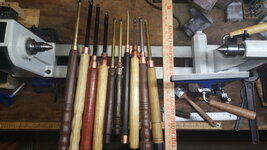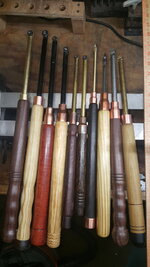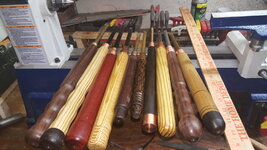I have a set of three full size Rockler carbide turning tools: square-radius, round, and diamond. They work well for me, but are probably not the greatest. At the time I bought them, I liked the feel of the tools and their size. For me, the larger size feels easier to control and manage.
https://www.rockler.com/full-size-square-radius-carbide-turning-tool
https://www.rockler.com/full-size-round-ergonomic-carbide-turning-tool
https://www.rockler.com/full-size-diamond-ergonomic-carbide-turning-tool
For the record, I also have the Sorby six-piece high speed steel (HSS) set that comes with the excellent turning book, which I bought on an inventory reduction sale at Rockler. I highly recommend that Sorby HSS set. I highly recommend the book, too. The book is very dry, but well written. The DVD is okay, but even more dry:
https://www.rockler.com/sorby-6-pie...-book-and-dvd-woodturning-a-foundation-course
Before I bought the Rockler carbide turning tools, I wanted to make sure there was an alternate source for replacement carbide tips, just in case Rockler ever drops that line of tools. AZ Carbide was very helpful. They are one of the vendors who support PenTurners.org. They carry a full range of replacement carbide tips for all brands of carbide tools, including the Rockler ones. I hope that someday they make their cross-reference chart easier to use. The Rockler-compatible tips are on page 4 of the cross-reference chart:
https://azcarbide.com
https://azcarbide.com/cross-reference-chart
https://www.penturners.org/forums/azcarbide.410/
In addition, there are other companies selling the Rockler tools under their own brands. Despite my web search skills, I never uncovered the real manufacturer. I assume they are made in in China at a company that is not well-known in the US. I found this example (Savannah) of nearly identical tools to the Rockler ones, but they are not the only company that brands the same tools with their own name:
https://www.ptreeusa.com/turn_brand_savannah.html
https://www.amazon.com/Savannah-Piece-Large-Carbide-Turning/dp/B01GQIYUZA
Mini turning set:
https://www.amazon.com/Savannah-Carbide-Turning-Perfect-Stoppers/dp/B01FWEX6OA
Here are some lessons learned about the Rockler carbide tips, and a few hints about carbide tips in general:
* In general, the tips MUST match the tools. You cannot install a round carbide tip in a square tool or vice-versa. The shape of the tool tip matches the carbide tip perfectly, and supports the back of the carbide tip snugly. There is one very important exception; see the next bullet.
* The square tip is a reasonable fit in the square radius tool. It is not a perfect fit, but it is so close that it works well. The square radius carbide tip does NOT fit the square tool at all. If you want to use both types of "square" tips in one tool, buy the square radius tool. I use the square radius tip 99% of the time, but there are a few uses for the square carbide tip, and I am pleased that the square radius tool will accommodate it.
* Regarding square radius carbide tips - Rockler's square radius carbide tips have a 2 inch radius. AZCarbide sells square radius carbide tips with different curves (2, 4, and 6 inch radii). I have not tried them yet, but someday want to see the difference for myself. (Caution: I do not know how well the 4 and 6 inch radius carbide tips will fit in Rockler's tool, which is designed to match a 2 inch radius carbide tip.)
* Regarding the square carbide tip - Rockler sells one kind of square tip with sharp corners that can leave lines if you are not skilled AND careful. AZCarbide sells identical square carbide tips, but they also sell square carbide tips with rounded corners. The rounded corners are designed to help you avoid leaving the sharp lines. I have not tried the rounded corner carbide tips yet, but someday want to see the difference for myself.
* Carbide tips start out sharp and are very long lasting and durable. What that means is that you get "happy sharp"(+) for a short time, and then "good enough sharp" for a long time.
* HSS tools dull much faster than carbide for sure, but with practice, you can sharpen them to "blissful sharp"(+) beyond carbide.
* I have both carbide and HSS turning tools at the lathe at the same time, and do not hesitate to switch between them. Adjust the tool rest accordingly.
* Size matters. At the time of purchase, I didn't fully understand that. Smaller tips let you to make smaller features on smaller turnings, like pens. I get by just fine, but now I understand why the store has so many different turning tools in different sizes.
* Consider other brands of carbide tools. I generally shop at the local Rockler store, which is convenient to me. They sell EZ Wood tools and Sorby's carbide tools as well. I might consider EZ Wood tools instead of the Rockler ones. I really like the feel of the Rockler tools in my hands when I work, but the EZ Wood tools seem like better quality overall. Several friends have used both tools, and they tell me that the EZ Wood tools are better. I wish I could characterize what "better" means.
* I have yet to be convinced that negative rake tips are that special. If I want to simulate negative rake, I adjust the tool rest, raise the handle and lower the tip to present it at a negative rake angle. It seems to work for me.
* Don't let anyone tell you that you cannot sharpen carbide tips. I have a set of diamond stones for sharpening chisels and hand plane irons, If you are careful, you can extend the life of your carbide tips by carefully flattening the backs of the carbide tips on diamond stones. Don't mess with the bevels at all. Flattening the backs will remove the small imperfections on the edges caused by previous use, effectively exposing a fresh beveled edge. I won't argue that it is as sharp as a new carbide tip, but it comes close, and works well for me. I still have my original carbide tips, and they are still very useable. It does not take much time or effort to sharpen carbide tips, and it works well.
Sharpening Hint: The etchings on the back of the carbide tip will disappear. Use a Sharpie pen to mark a dot on the starting edge after you finish sharpening the carbide tip, so you know when you have rotated through all the edges and it is time to resharpen.
* Buy a spare set of carbide tips for whatever you own. That way, you can switch out worn tips with fresh ones, and then resharpen your "dull" tips later, at your convenience.
* Carbide tools are not the end-all, be-all solution. At the very least, I would still want a good parting tool. You can try to replace the parting tool with the diamond tool, but they are not the same. In addition, I would miss having a skew chisel, too.
(+) Note: "happy sharp" and "blissful sharp" are my terms, trying to describe the difference between the sharpness that can be achieved with carbide tips vs. HSS turning tools. I feel reasonably happy with carbide tools, but there is nothing that describes the feeling of sheer joy (bliss! ecstasy!) of using a freshly sharpened HSS tool doing its work. Yeah, the HSS needs resharpening often, but you can learn to sharpen them beyond what carbide can do.
Most of the above notes apply equally well to Rockler's mini turning set (currently on sale) that
@Pollock29 asked about:
https://www.rockler.com/carbide-mini-turning-tool-3-piece-set
Rockler also sells an even smaller three piece pen turning set. They are very very small. Rockler does not include a diamond carbide tip tool with that smallest carbide pen turning set. Instead, they include a small HSS parting tool. (What was Rockler thinking? How is the owner is going to sharpen that one HSS tool, anyway?). In my opinion, you trade a lot of versatility for making anything other than pens and very small turnings, but here they are:
https://www.rockler.com/carbide-pen-turning-tool-3-piece-set
Someday I may try other solutions, like the "magic skew". Right now, the tools I have are working out fine. If you buy a tool and it doesn't work out, you can always sell it to someone else. Consider the relatively small loss part of your "education budget."

Do your homework and take your time. Whatever you choose will broaden your experience and add to your skill set. I hope this helps.
Thank you so much! I am going to have to do quite a lot of research, and you have given me much to consider. It does get pretty confusing some time the more you read, but I trust your experience! I think I need to attend some clinics as well, or try out some of the different types for feel and ease of use. You have given me much to ponder!



